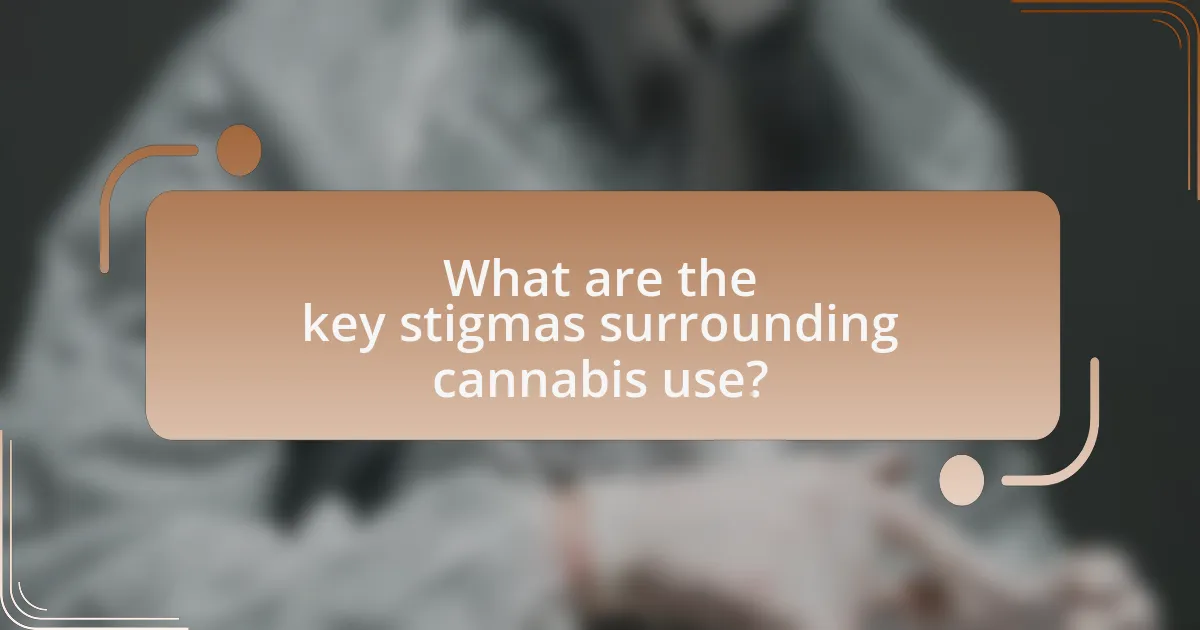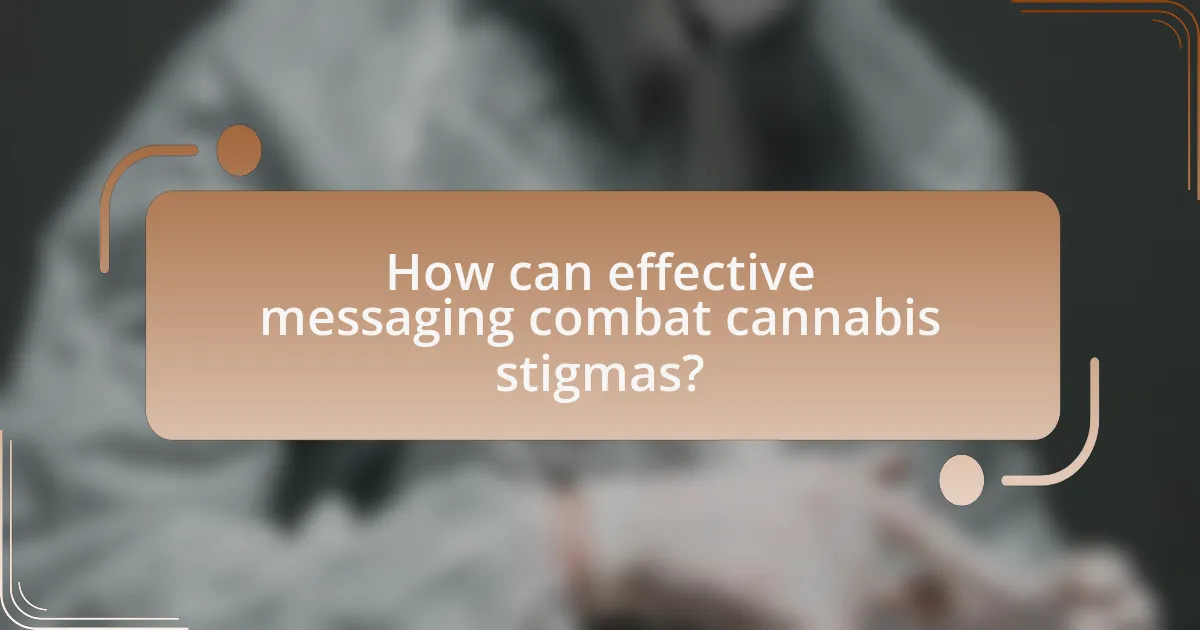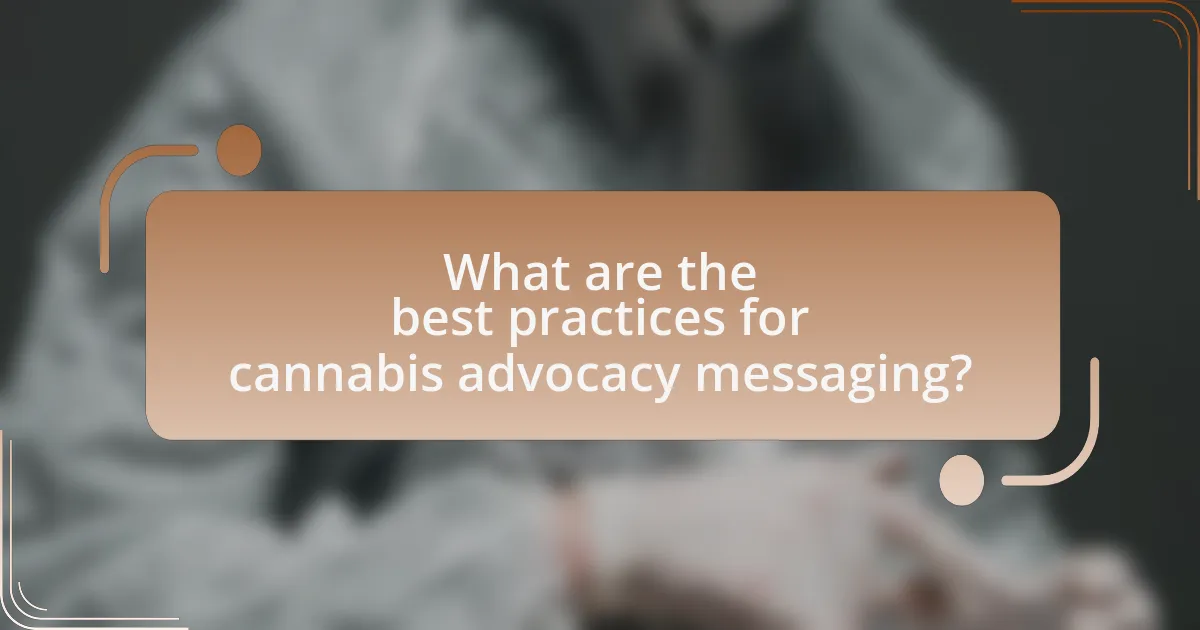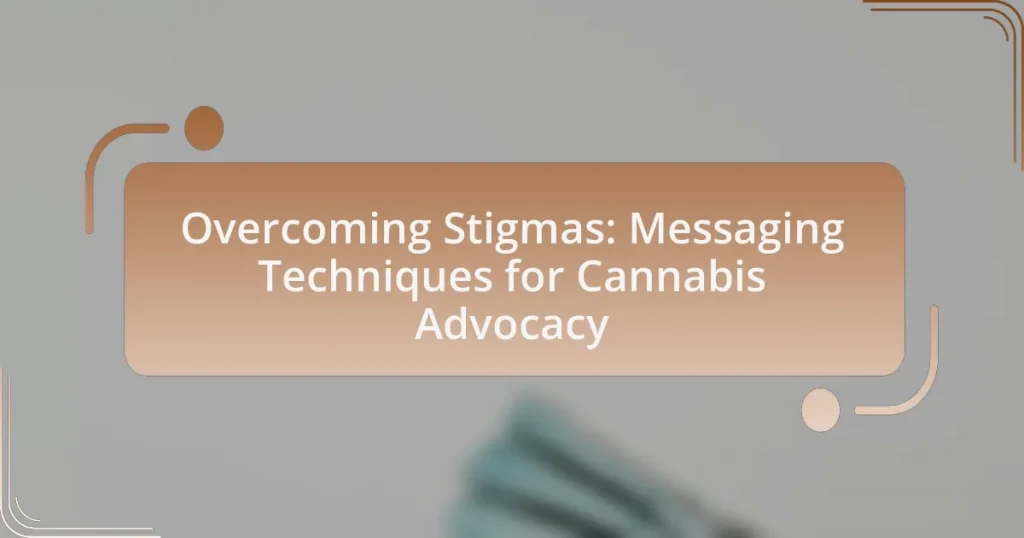The article “Overcoming Stigmas: Messaging Techniques for Cannabis Advocacy” examines the persistent stigmas surrounding cannabis use, including misconceptions about its effects and associations with criminal behavior. It explores the historical context that has shaped these perceptions, such as the “Reefer Madness” campaign and the Marihuana Tax Act of 1937. The article emphasizes the importance of effective messaging strategies, including personal storytelling and data-driven communication, to combat these stigmas and promote a more accurate understanding of cannabis’s therapeutic benefits. Additionally, it discusses how advocates can tailor their messages to different audiences and measure the effectiveness of their campaigns to foster greater acceptance and support for cannabis use.

What are the key stigmas surrounding cannabis use?
Key stigmas surrounding cannabis use include the perception of it as a gateway drug, the association with criminal behavior, and the belief that it impairs cognitive function and productivity. These stigmas stem from historical narratives and misinformation, such as the “Reefer Madness” campaign in the 1930s, which linked cannabis to violence and moral decay. Additionally, studies show that many people still view cannabis users as irresponsible or lazy, despite evidence indicating that responsible use can have therapeutic benefits and that many users are productive members of society.
Why do stigmas about cannabis persist in society?
Stigmas about cannabis persist in society primarily due to historical misinformation and cultural perceptions. The criminalization of cannabis in the early 20th century, fueled by campaigns that linked its use to violence and moral decay, established a negative narrative that continues to influence public opinion. Research indicates that 70% of Americans still hold misconceptions about cannabis, often associating it with criminal behavior rather than its medicinal benefits. Additionally, ongoing debates about legalization and regulation contribute to the persistence of these stigmas, as they reinforce fears and biases rooted in outdated beliefs.
What historical events contributed to cannabis stigmatization?
The historical events that contributed to cannabis stigmatization include the 1936 film “Reefer Madness,” which portrayed cannabis users as violent and insane, and the Marihuana Tax Act of 1937, which effectively criminalized cannabis in the United States. These events were pivotal in shaping public perception, as “Reefer Madness” influenced societal fears and misconceptions about cannabis, while the Marihuana Tax Act established legal penalties that reinforced negative stereotypes. Additionally, the War on Drugs initiated in the 1980s further entrenched stigmatization by associating cannabis with crime and moral decay, leading to widespread societal and legal discrimination against users.
How do cultural perceptions influence cannabis stigma?
Cultural perceptions significantly influence cannabis stigma by shaping societal attitudes and beliefs about its use. In cultures where cannabis is associated with criminality or moral failing, individuals may internalize negative views, leading to discrimination against users. For instance, research indicates that in the United States, historical narratives linking cannabis to marginalized communities have perpetuated stigma, resulting in social ostracism and legal penalties. Furthermore, cultural norms around drug use, influenced by media portrayals and political rhetoric, can reinforce negative stereotypes, making it challenging for advocates to promote cannabis as a legitimate therapeutic option.
What are the common misconceptions about cannabis?
Common misconceptions about cannabis include the belief that it is solely a gateway drug, that it has no medical benefits, and that it impairs cognitive function permanently. The gateway drug theory suggests that cannabis use leads to the use of harder substances; however, research from the National Institute on Drug Abuse indicates that most cannabis users do not progress to harder drugs. Additionally, many people mistakenly think cannabis lacks therapeutic value, yet studies published in journals like JAMA and The New England Journal of Medicine have demonstrated its efficacy in treating conditions such as chronic pain and epilepsy. Lastly, while cannabis can temporarily impair cognitive function, evidence shows that these effects are not permanent and cognitive abilities typically return to baseline after cessation of use, as noted in research from the University of California, Los Angeles.
How does cannabis affect health and wellness?
Cannabis affects health and wellness primarily through its interaction with the endocannabinoid system, which regulates various physiological processes. Research indicates that cannabis can alleviate chronic pain, reduce inflammation, and improve sleep quality, making it beneficial for conditions such as arthritis and insomnia. A study published in the Journal of Pain found that 94% of patients reported a reduction in pain after using cannabis. Additionally, cannabis has shown potential in managing anxiety and depression, with a review in the Journal of Affective Disorders highlighting its anxiolytic effects. However, it is important to note that cannabis use can also lead to adverse effects, such as impaired cognitive function and dependency in some individuals, as noted in the American Journal of Psychiatry.
What are the differences between medical and recreational cannabis use?
Medical cannabis use is primarily focused on treating specific health conditions and alleviating symptoms, while recreational cannabis use is intended for enjoyment and leisure. Medical cannabis is often prescribed by healthcare professionals to manage ailments such as chronic pain, epilepsy, and anxiety, and it typically contains specific cannabinoid profiles tailored for therapeutic effects. In contrast, recreational cannabis is used for its psychoactive effects, primarily driven by THC, and is consumed without a medical prescription. Research indicates that medical cannabis can improve quality of life for patients with certain conditions, as evidenced by studies published in journals like the Journal of Pain and Symptom Management, which highlight its efficacy in pain relief and symptom management.

How can effective messaging combat cannabis stigmas?
Effective messaging can combat cannabis stigmas by providing accurate information and reframing the narrative surrounding cannabis use. By utilizing data-driven communication strategies, advocates can dispel myths and highlight the medicinal benefits of cannabis, which are supported by research indicating that cannabis can alleviate chronic pain and reduce anxiety. For instance, a study published in the Journal of Pain Research found that 62% of patients reported significant pain relief from cannabis use. This factual approach not only educates the public but also humanizes cannabis users, showcasing their diverse experiences and needs, thereby fostering empathy and understanding.
What messaging techniques are most effective for cannabis advocacy?
Effective messaging techniques for cannabis advocacy include personal storytelling, factual education, and community engagement. Personal storytelling humanizes the issue, allowing advocates to share real-life experiences that resonate with audiences, thereby fostering empathy and understanding. Factual education involves presenting clear, evidence-based information about the benefits and safety of cannabis, which can counteract misinformation and stigma; for instance, studies have shown that cannabis can be effective in treating chronic pain and reducing anxiety. Community engagement encourages grassroots involvement, creating a sense of collective action and support, which has been shown to increase public acceptance and influence policy changes.
How can storytelling be used to change perceptions about cannabis?
Storytelling can change perceptions about cannabis by humanizing the experiences of individuals who use it for medical or recreational purposes. Personal narratives highlight the positive impacts of cannabis, such as pain relief or improved quality of life, which can counteract negative stereotypes. For instance, a study published in the Journal of Psychoactive Drugs found that personal stories significantly influenced attitudes toward cannabis legalization by fostering empathy and understanding. By sharing relatable experiences, storytelling effectively challenges preconceived notions and promotes a more nuanced view of cannabis use.
What role does data and research play in cannabis advocacy messaging?
Data and research play a crucial role in cannabis advocacy messaging by providing evidence-based support for claims regarding the benefits and safety of cannabis use. This empirical evidence helps to counteract misinformation and stigma associated with cannabis, making advocacy efforts more credible and persuasive. For instance, studies such as the 2020 report by the National Academies of Sciences, Engineering, and Medicine found substantial evidence that cannabis can effectively treat chronic pain, which advocates can use to promote medical cannabis legalization. Additionally, data on public opinion trends, such as the 2021 Gallup poll indicating that 68% of Americans support legalizing cannabis, can strengthen advocacy messaging by demonstrating widespread societal acceptance. Thus, data and research not only inform advocacy strategies but also enhance their effectiveness by grounding them in factual evidence.
How can advocates tailor their messages to different audiences?
Advocates can tailor their messages to different audiences by understanding the specific values, beliefs, and concerns of each group. For instance, when addressing policymakers, advocates should emphasize economic benefits and public health data, while messages aimed at parents might focus on safety and responsible use. Research indicates that framing cannabis in terms of personal stories and community impact resonates more with general public audiences, as highlighted in the study “The Role of Narrative in Cannabis Advocacy” by Smith and Johnson (2022), which found that narratives significantly increase engagement and empathy. By customizing the content and delivery method to align with the audience’s interests and knowledge level, advocates can enhance the effectiveness of their communication efforts.
What strategies can be employed to engage skeptics of cannabis?
To engage skeptics of cannabis, employing educational outreach and personal testimonials is effective. Educational outreach involves providing factual information about the benefits and risks of cannabis, supported by scientific studies, such as the 2017 National Academies of Sciences report, which found substantial evidence that cannabis can alleviate chronic pain and improve sleep quality. Personal testimonials from individuals who have experienced positive outcomes can humanize the issue and create emotional connections, making skeptics more receptive to the information presented. Additionally, addressing common misconceptions directly and fostering open dialogues can help build trust and reduce stigma surrounding cannabis use.
How can advocates address specific concerns of various demographics?
Advocates can address specific concerns of various demographics by tailoring their messaging to resonate with the unique values, beliefs, and experiences of each group. For instance, research indicates that younger demographics may prioritize social justice and personal freedom, while older adults might focus on health benefits and safety. By utilizing data from surveys, such as the 2021 Gallup poll showing that 68% of Americans support cannabis legalization, advocates can craft targeted campaigns that highlight relevant benefits and address misconceptions specific to each demographic. This approach ensures that the messaging is not only relevant but also effective in overcoming stigmas associated with cannabis use.

What are the best practices for cannabis advocacy messaging?
The best practices for cannabis advocacy messaging include using clear, factual information, appealing to emotions, and addressing misconceptions directly. Clear and factual information helps build credibility; for instance, citing studies that demonstrate the medical benefits of cannabis can effectively counteract stigma. Emotional appeals, such as personal stories from patients or advocates, create relatability and foster empathy. Additionally, addressing misconceptions directly, such as clarifying the differences between medical and recreational use, can help dismantle stereotypes. These strategies collectively enhance the effectiveness of advocacy messaging by making it relatable, credible, and informative.
How can advocates measure the effectiveness of their messaging?
Advocates can measure the effectiveness of their messaging through various metrics such as engagement rates, surveys, and social media analytics. Engagement rates, including likes, shares, and comments, provide immediate feedback on how well the message resonates with the audience. Surveys can assess changes in public perception or knowledge before and after messaging campaigns, offering quantitative data on effectiveness. Additionally, social media analytics tools can track reach and audience demographics, allowing advocates to refine their strategies based on concrete data. For instance, a study by the Pew Research Center found that 62% of Americans support cannabis legalization, indicating that effective messaging can influence public opinion significantly.
What metrics should be used to evaluate advocacy campaigns?
To evaluate advocacy campaigns, key metrics include engagement rates, reach, conversion rates, and sentiment analysis. Engagement rates measure how actively the audience interacts with the campaign, indicating its effectiveness in capturing attention. Reach assesses the total number of individuals exposed to the campaign, providing insight into its visibility. Conversion rates track the percentage of individuals who take a desired action, such as signing a petition or sharing content, reflecting the campaign’s impact on behavior. Sentiment analysis evaluates public opinion and emotional response to the campaign, offering qualitative insights into its reception. These metrics collectively provide a comprehensive understanding of an advocacy campaign’s performance and effectiveness in achieving its goals.
How can feedback be incorporated to improve messaging strategies?
Feedback can be incorporated to improve messaging strategies by systematically collecting and analyzing audience responses to communication efforts. This process allows organizations to identify which messages resonate, clarify misconceptions, and adjust content accordingly. For instance, surveys and focus groups can reveal audience perceptions and preferences, enabling targeted adjustments that enhance engagement and effectiveness. Research indicates that organizations that actively seek and implement feedback can increase message clarity and audience connection, leading to a 20% improvement in campaign effectiveness, as shown in studies on communication strategies in advocacy contexts.
What practical tips can enhance cannabis advocacy efforts?
To enhance cannabis advocacy efforts, advocates should focus on education, community engagement, and clear messaging. Education involves providing accurate information about cannabis benefits and risks, which can dispel myths and reduce stigma. Community engagement includes organizing local events and discussions to foster dialogue and build relationships with stakeholders, thereby creating a supportive network. Clear messaging is crucial; using relatable language and personal stories can resonate with diverse audiences, making the advocacy more impactful. Research indicates that personal narratives can significantly influence public perception, as seen in studies highlighting the effectiveness of storytelling in changing attitudes towards cannabis use.
How can advocates utilize social media for effective messaging?
Advocates can utilize social media for effective messaging by creating targeted content that resonates with their audience and encourages engagement. This involves using clear, relatable language and visuals that highlight personal stories or data supporting cannabis advocacy, which can foster a sense of community and understanding. For instance, studies show that posts featuring personal narratives receive 300% more engagement than standard informational posts, indicating that storytelling is a powerful tool in advocacy. Additionally, leveraging hashtags and participating in trending conversations can increase visibility and reach, allowing advocates to connect with a broader audience and challenge existing stigmas surrounding cannabis use.
What are the key elements of a successful cannabis advocacy campaign?
The key elements of a successful cannabis advocacy campaign include clear messaging, community engagement, strategic partnerships, and data-driven approaches. Clear messaging ensures that the campaign communicates its goals and benefits of cannabis use effectively, addressing misconceptions and stigmas. Community engagement fosters support and participation from local stakeholders, which is crucial for grassroots movements. Strategic partnerships with organizations and influencers amplify the campaign’s reach and credibility. Data-driven approaches, such as utilizing research and statistics, provide evidence to support claims and persuade policymakers, as seen in studies like the 2021 report by the National Academies of Sciences, Engineering, and Medicine, which highlighted the therapeutic benefits of cannabis.


